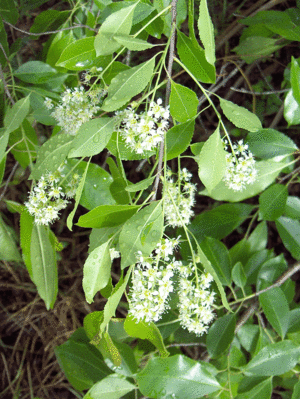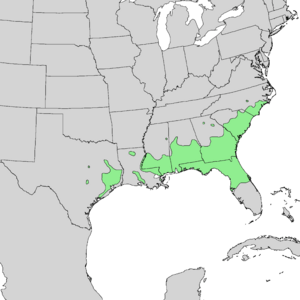Prunus caroliniana facts for kids
Quick facts for kids Prunus caroliniana |
|
|---|---|
 |
|
| Conservation status | |
| Scientific classification | |
| Genus: |
Prunus
|
| Species: |
caroliniana
|
 |
|
| Natural range of Prunus caroliniana | |
| Synonyms | |
|
|
The Prunus caroliniana, often called the Carolina laurelcherry or Carolina cherry laurel, is a small evergreen tree. It grows naturally in the lowlands of the Southeastern United States. You can find it from North Carolina all the way south to Florida and west into central Texas. This tree has also started growing wild in some parts of California.
It's important not to confuse the Carolina laurelcherry with its European cousin, Prunus laurocerasus. That tree is also sometimes called Cherry Laurel, but in the U.S., it's usually known as English Laurel.
Contents
What Does It Look Like?
The Carolina laurelcherry is a small to medium-sized evergreen tree. This means it keeps its leaves all year long. It usually grows to be about 5–13 meters (16–43 ft) tall. Its branches can spread out about 6–9 meters (20–30 ft) wide.
Leaves, Branches, and Flowers
The leaves are dark green, shiny, and feel a bit leathery. They are arranged alternately along the stem. Their shape is usually oval or wider at the tip. Each leaf is about 5–12 cm (2–4.5 in) long. Most of the time, the edges of the leaves are smooth. However, younger trees might have very small, subtle teeth on their leaf edges. The base of the leaf is wedge-shaped. The young branches are reddish to grayish-brown, thin, and smooth.
In late winter or early spring, the tree produces lovely, fragrant white or cream-colored flowers. These flowers grow in long clusters called racemes, which are about 5–8 cm (2–3 in) long. After the flowers, tiny black cherries appear. They are about 1 cm (0.5 in) across. These little fruits stay on the tree through the winter. Birds especially love to eat them from February to April.
Important Facts About the Plant
The leaves and branches of the Carolina laurelcherry contain natural chemicals. If these parts of the plant are damaged, they can release substances that are harmful if eaten. This is why grazing animals like deer usually avoid eating this tree. When you crush the leaves or green twigs, they often smell like maraschino cherries or almond extract.
Wildlife and the Carolina Laurelcherry
This tree is very important for many animals and insects. It acts as a "host plant" for several types of butterflies. This means the butterflies lay their eggs on the tree, and their caterpillars eat its leaves. Some of these butterflies include the coral hairstreak, eastern tiger swallowtail, red-spotted purple, spring azures, and summer azures.
While adult butterflies drink nectar from the spring flowers, many animals enjoy the fruits. Songbirds, wild turkeys, quail, raccoons, foxes, and small mammals all eat the small black cherries.
Growing This Tree
The Carolina laurelcherry has been a popular choice for gardens and landscapes for a long time. People often use it as an ornamental tree or to create a privacy hedge in the eastern parts of the United States. It's known to be a tough evergreen tree that doesn't get too big.
What It Needs to Grow Well
This tree grows best in full sunlight. It also prefers soil that drains well and is a bit acidic. If the soil is too alkaline (the opposite of acidic), the leaves might turn yellow. This condition is called chlorosis. The Carolina laurelcherry can grow at elevations up to about 152 m (500 ft). It can handle cold temperatures in USDA zones 7B through 10A.
Special Varieties
There are a few special types, or "cultivars," of the Carolina laurelcherry that people have grown:
- Prunus caroliniana 'Compacta': This variety grows to be about half the size of a regular Carolina laurelcherry tree.
- Prunus caroliniana 'Cherry Ruffles': This type has leaves with wavy or ruffled edges.


